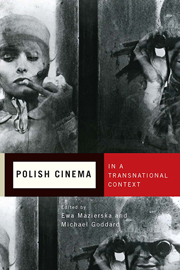Book contents
- Frontmatter
- Contents
- Acknowledgments
- Introduction: Polish Cinema beyond Polish Borders
- Part One The International Reception of Polish Films
- Part Two Polish International Coproductions and Presence in Foreign Films
- 6 Postcolonial Heterotopias: A Paracinematic Reading of Marek Piestrak's Estonian Coproductions
- 7 Poland-Russia: Coproductions, Collaborations, Exchanges
- 8 Train to Hollywood: Polish Actresses in Foreign Films
- 9 Polish Performance in French Space: Jerzy Radziwiłowicz as a Transnational Actor
- 10 Polish Actor-Directors Playing Russians: Skolimowski and Stuhr
- Part Three Émigré and Subversive Polish Directors
- Selected Bibliography
- List of Contributors
- Index
8 - Train to Hollywood: Polish Actresses in Foreign Films
from Part Two - Polish International Coproductions and Presence in Foreign Films
Published online by Cambridge University Press: 05 April 2014
- Frontmatter
- Contents
- Acknowledgments
- Introduction: Polish Cinema beyond Polish Borders
- Part One The International Reception of Polish Films
- Part Two Polish International Coproductions and Presence in Foreign Films
- 6 Postcolonial Heterotopias: A Paracinematic Reading of Marek Piestrak's Estonian Coproductions
- 7 Poland-Russia: Coproductions, Collaborations, Exchanges
- 8 Train to Hollywood: Polish Actresses in Foreign Films
- 9 Polish Performance in French Space: Jerzy Radziwiłowicz as a Transnational Actor
- 10 Polish Actor-Directors Playing Russians: Skolimowski and Stuhr
- Part Three Émigré and Subversive Polish Directors
- Selected Bibliography
- List of Contributors
- Index
Summary
Much has been written about Polish directors crossing borders, and several essays in this volume further attest to this phenomenon. A much less explored phenomenon is the presence of Polish actors and actresses in international cinema, the careers of the latter being the topic of this study. Yet, it is a significant aspect of Polish cinema; from Pola Negri to Alicja Bachleda-Curuś, the matter of Polish actresses in large numbers boarding trains to Budapest, Prague, Munich, and of course, Hollywood. Some of them reached their destination and stayed there for good; others returned after making one film, either directly to Łódź or Warsaw, or taking a detour to other cinematic capitals. Each case of success or its lack is unique, as film performance and stardom are highly composite phenomena and there are many factors underlying why somebody is employed in a foreign film and how his or her role is received. However, there are also certain recurrent factors facilitating or hampering actors' foreign careers, such as, for example, their age, whether they have a family and especially children in their own country, and, in the case of those coming from the socialist bloc, the ease of obtaining a passport and visa or even being able to afford the trip.
In this chapter I want to discuss the cases of four Polish actresses who literally and metaphorically crossed the border: Lucyna Winnicka, Krystyna Janda, Katarzyna Figura, and Alicja Bachleda-Curuś. I settled on these four actresses for two principal reasons. First, they represent different generations—the oldest being born in the 1920s, the youngest in the 1980s—and their attempts to win foreign markets took place in different political and cultural circumstances. Establishing how these circumstances facilitated or limited their successes is one of the aims of this essay.
- Type
- Chapter
- Information
- Polish Cinema in a Transnational Context , pp. 153 - 173Publisher: Boydell & BrewerPrint publication year: 2014

